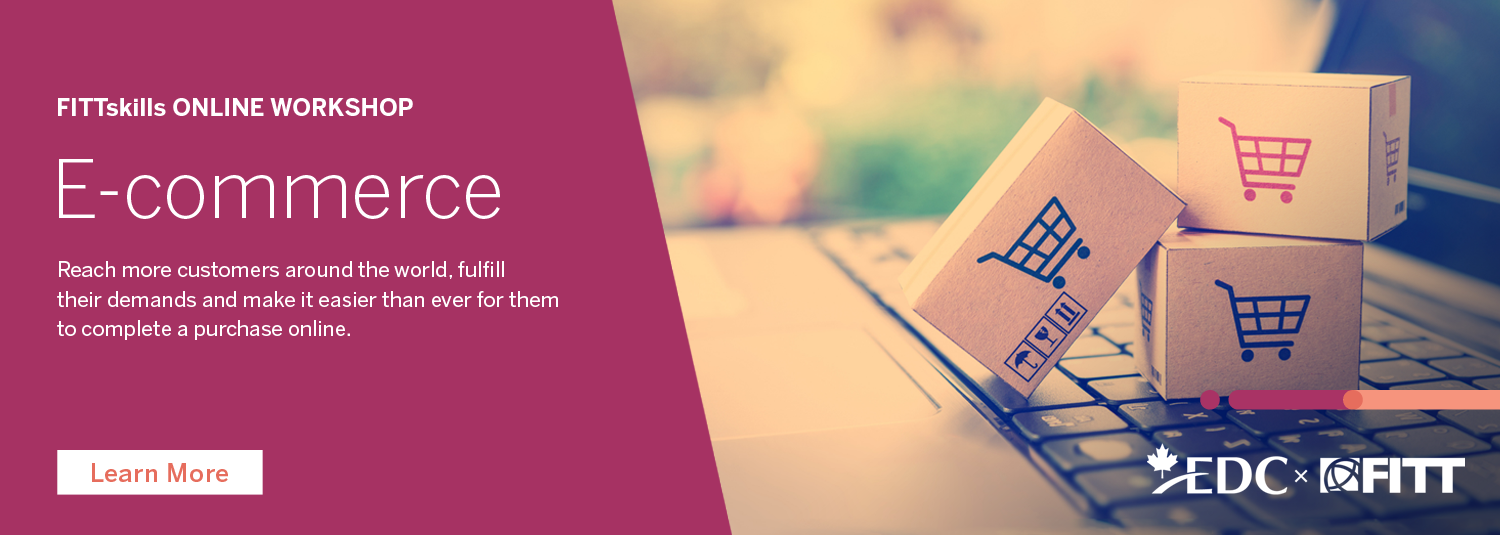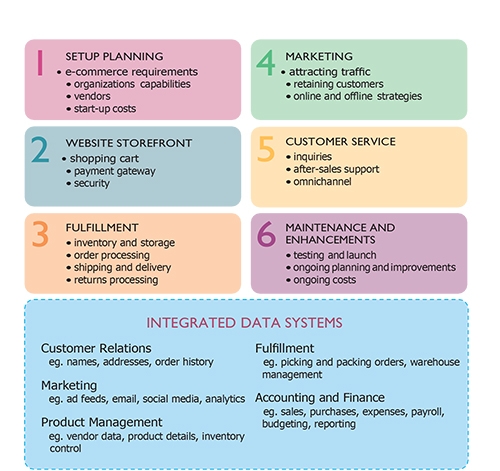
E-commerce presents opportunities worth exploring. An e-commerce operation can overcome key challenges presented by exporting and importing.
The need to travel to other countries to negotiate sales with customers and contracts with partners is reduced, and in some cases, eliminated. The need for organizational representatives and infrastructure in international markets is not necessary in many cases, depending on the nature of the industry and the products and services being sold.
E-commerce is not without its own challenges and those considering setting up this type of operation should inform themselves about the required components and recommended practices.
Things to consider and prepare for include setting up an integrated model and localizing sites for international markets.
Using an integrated e-commerce model
The goal of an integrated solution is to increase revenue and reduce costs by introducing operating efficiencies. A well-designed integrated model can help e-commerce operations achieve efficiencies by allowing them to reuse product data in several different operations. An integrated model provides fast access to customer history and information for online, call centre and physical operations. It can refer to past purchases and potentially upsell from an automated system. If an order management system is connected to the accounting system, there is no need to manually post order information.
Having product data centralized allows organizations to use it in feeds, on their website, in the call centre and in the physical stores of multichannel operations. Finally, data can be integrated and automation introduced for fulfillment and back office processes. A well-designed integrated system minimizes the number of places where an organization stores data. Ideally, there is a single database for all operational systems.
The more integrated the systems, the more likely the organization’s processes will be simplified. Five recommended data systems for integration into the e-commerce platform include:
- Customer relations, e.g. name, address, order history
- Marketing, e.g. ad feeds, email, social media, analytics
- Product management, e.g. vendor data, product details, inventory control
- Fulfillment, e.g. picking and packing orders, warehouse management
- Accounting and finance, e.g. sales, purchases, expenses, payroll, budgeting, reporting
E-commerce operations wanting to link their online sales and data to other business operations such as inventory and accounting are advised to seek software with integration abilities. Traditionally, e-commerce functions have been managed by separate software systems, creating silos that suffered from a lack of information sharing and consistency.
To set-up e-commerce operations in the past, businesses would purchase on-site, standalone e-commerce software that required extensive ICT setup and in-house management. E-commerce software was purchased to provide the customer-facing, front-end component of online businesses. Additional software was needed to manage back end functions such as accounting, order processing, inventory management and customer service.
Piecing together the different types of software to create a complete e-commerce business platform was complicated, required frequent maintenance and rarely functioned efficiently. On top of that, this approach was often costly, not scalable and time consuming to customize.
New software, known as software-as-a-service or SaaS, allows integration of e-commerce and business functions into a single e-commerce platform.
SaaS provides infrastructure that unifies business applications and feeds them data that enables personalized online customer experiences. There are additional benefits of the integrated SaaS model. It allows customer service representatives to follow customers across all channels. It provides a centralized order and inventory management system that can efficiently fulfill orders from all sales channels. It can use a customer’s order history data to provide relevant offers.
Want to learn more about how to assess your position in the e-commerce marketplace by understanding your operational needs, capabilities, opportunities and challenges? Check out the FITTskills E-commerce online workshop!
Localizing sites for international markets
Localization is important to e-commerce operations that target international markets. Elements to consider in the design of an international e-commerce operation include:
- Region-specific payment options, including the use of local currencies and applicable local taxes, and the provision of payment options based on local practices and preferences
- The ability to manage multiple languages, which can be automatically determined via IP address or can be selected when the visitor lands at a site
- Support of a single product catalogue that can service any country
- Use of region-specific search engine marketing
- Provision of customer support services such as a help lines and live chat features which can handle inquiries in different languages
- Adaption of the website so its image and content appeal to cultural preferences of each international market, e.g. colours and sports teams
- Establish distribution channels to the international market
A more advanced strategy is to create a new website for each country the organization targets and purchase the Top Level Domain (TLD) of that country. For example, for a website targeted at Mexico, the organization would seek the same domain name but use the .mx extension. It is important to acquire the relevant domain name for the local market. Someone who is fluent in both the language of the original content and the destination language should translate the website content, along with the meta tags.
Organizations should consider collaborating with native speakers, who, in addition to language fluency, have an understanding of language variations, colloquialisms and cultural context that can help ensure key information and marketing messages are conveyed online accordingly.
In addition, an organization that is ready to allocate extensive resources towards globalizing their e-commerce operations will want to consider tailoring the promotions and featured products to the needs of the local market. Furthermore, they will adjust the user experience to suit the culture. For instance, in Sweden, simplicity and speed are most important, whereas the French online shopper prefers a more design-led experience.
All these localization activities help with Search Engine Optimization (SEO), as well as creating a positive impression with customers in the international market. Search engines and people generally prefer websites that represent the home country.
When selecting an e-commerce platform, its localization capabilities should be considered, such as the ability to:
-
- Create localized online content and sales processes.
- Create subdirectories or separate websites for each language targeted.
- Include a Content Management System (CMS) or capability that allows the organization to make unique adaptations for each country.
- Address problems at a global level rather than requiring individual country-level remediation.
- Host additional country sites within its environment.
- Integrate third-party applications, such as a fulfillment company, as the organization adds new localized sites.
- Route IP addresses to the relevant website.







disqus comments